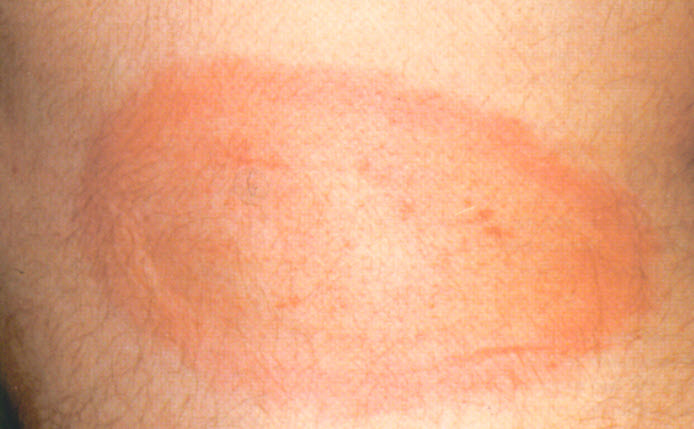Question 13#
A 22-year-old man presents to your office with complaint of right knee pain and swelling for the past 2 weeks. Although uncomfortable, it has not prevented ambulation. He denies any fevers or night sweats. He reports that he has had several similar episodes of knee and ankle pain over the past few months. He reports malaise and fatigue over the past few months as well. He has had four sexual partners over the past 6 months but denies dysuria or urethral discharge. With prompting, the patient recalls a rash on his arm accompanied by fever after a trip to upstate New York to attend a music festival. He felt the rash was interesting, and took a picture which he saved to his smart-phone (see below). Which of the following would be the most appropriate next step in the management of this disease?

A. Urethral swab and empiric treatment for Chlamydia
B. Empiric therapy with doxycycline
C. Antibody titers for Lyme disease
D. Empiric corticosteroids
E. Testing for rheumatoid factor and anti-cyclic citrullinated peptide (CCP)
Correct Answer is B
Comment:
The patient in question has Lyme disease. Lyme disease is caused by infection with the spirochete Borrelia burgdorferi, transmitted by the bite of the Ixodes tick. In the United States, most cases are reported in the Northeast and North-central parts of the country. The majority of patients develop a characteristic rash (erythema migrans) which slowly expands over days before resolving. As the spirochete disseminates, patients can develop aseptic meningitis, nerve palsies, and cardiac conduction abnormalities. Patients will frequently develop a migratory monoarticular arthritis that can recur intermittently for months to years. The diagnosis of Lyme disease is difficult if erythema migrans (EM) is not present. With the documentation of EM and a history consistent with Lyme disease (high suspicion) additional testing is not indicated, and the patient should be treated empirically with antibiotics. Answer c is incorrect because of the high pretest probability that this patient has Lyme disease. In the absence of an EM lesion, the diagnostic picture becomes murkier. For moderate pretest probability patients, it has been recommended that Lyme disease titers be tested. For low-probability patients, neither titers nor empiric therapy are recommended. Although the patient may benefit from STD testing and treatment after his attendance to the music festival (answer a), the rash shown is not consistent with chlamydial induced reactive arthritis. As the pathogenesis of Lyme disease is fundamentally one of infection rather than immune dysregulation, empiric steroid therapy would not be indicated (answer d). It would be highly unusual for rheumatoid arthritis (answer e) to present as primarily knee involvement in this demographic, and RA would not account for the associated rash.